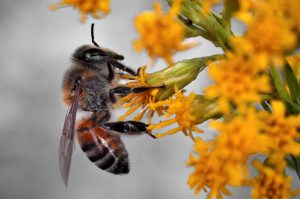Honey bees exposed to pesticides via contaminated wild plant pollen
 Photo credit: Lucas Zallio
Photo credit: Lucas Zallio
A recently published article in the scientific journal Nature Communications has found that contaminated pollen from wild plants near land cultivated for corn and soy production is a source of pesticide exposure throughout the entire season. Researchers sought to understand the extent of environmental contamination with pesticides, particularly neonicotinoids, that are known to disperse from crop fields into surrounding environments via dust, eventually contaminating soil and water. Researchers placed two honey bee hives at three different sites—a natural open meadow, the border of a corn field treated with neonicotinoid insecticides, and the border of a corn field not treated with insecticides. Pollen collected by the honeybees was identified (aka what plant the pollen come from) and screened for pesticides. The results showed that the majority of pollen collected by the honey bees did not come from agricultural crops but instead was collected from wild plants surrounding crop fields. Furthermore, the pollen collected by honey bees from all three sites was contaminated by numerous pesticides throughout the entire season. While agricultural pesticides were common contaminants, pyrethroid insecticides used for the control of mosquitoes and other pests were detected at the highest concentration at all three sites. “Our work demonstrates that the pest-management practices employed both within crop fields and beyond have implications for honey bee and other pollinator populations in the area, as both urban and agricultural pesticides were relatively common in all types of pollen throughout the season,” the researchers noted.


